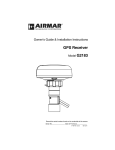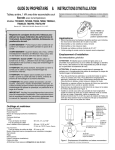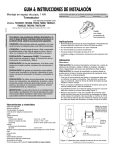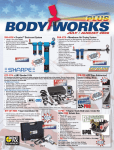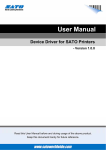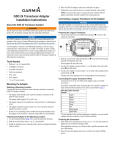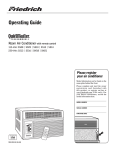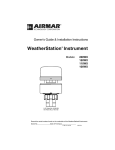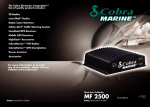Download Presented by Airmar
Transcript
Seminar Agenda 1. 2. 3. 4. 5. 6. 7. 8. 9. NMEA 2000® Products Response to Customer Feedback Airmar Transducer Models Installation-Specific Products Converting Transducers Installation & Troubleshooting In-Hull Transducers Broadband Transducers Transom-Mount Installation & Troubleshooting NMEA 2000® Sensors NMEA 0183 & 2000® Smart Sensors •All signal processing is done inside the transducer •Operates at 235kHz •No interference with on-board 50/200 kHz sounder •Provides digital depth, speed, and temperature •Separate models for 0183 and 2000 NMEA 0183 Smart Sensors are compatible with all NMEA 0183 displays that can read the following sentences: $SDDBT, DDPT....Depth $VWVHW........... Speed $VWVLW............ Distance $YXMTW.............Water Temperature NMEA 2000 Smart Sensors are compatible with all NMEA 2000 displays that can read the following PGN’s: 128259........ Speed Water Reference 128267.........Water Depth and Transducer 128275........ Distance Log 130310........ Water Temperature NEW NMEA 2000 B744V • • • • • • • Depth, speed, and temperature 235 kHz 100 Watts Power with broadband ceramic Minimum Depth Range: 0.5 m (1.6’) Maximum Depth Range: Up to 180 m (590’) Bronze housing For installations requiring a High-Performance Fairing NEW NMEA 2000 ST850 & ST800 • • • • • • • Speed and temperature 6 m (20’) NMEA 2000 cable Devicenet connector ST850 retrofits into existing Airmar P17 & B17 2” housings ST800 retrofits into existing Airmar P120 & B120 2” housings Retractable housing with water valve Plastic, bronze, or stainless steel housings NEW NMEA 2000 B122 Long-Stem • • • • • • • Depth and temperature 235 kHz 100 Watts Power with broadband ceramic Minimum Depth Range: 0.5 m (1.6’) Maximum Depth Range: Up to 180 m (590’) Bronze, long-stem housing For steep deadrise and thick hull vessels DT800 Tilted Element™ Smart Sensors New design incorporates: • Broadband 235kHz Ceramic • Higher power rating (100W) • Increased depth capability down to 600ft • Better shallow water performance(<1.6 ft) DT800 Tilted Element™ Benefits •Available in 0°, 12°, or 20° Tilts With Tilt Without Tilt DT800 vs. DST800 •Broadband, round ceramic •Better sensitivity vs. DST800 •12° beam, 590’ max depth •Fixed 0°, 12°, or 20° tilt Ceramic shape: •Rectangular bar ceramic •Three sensors in one housing •10° x 44° beam, 330’ max depth •Works with all deadrise angles Ceramic shape: Smart™ Sensor Family • Converts NMEA 2000® PGNs to USB format • Plug-and-play connectivity from a NMEA 2000 network backbone to a PC • For Airmar NMEA 2000 Sensors and other Certified NMEA 2000 Sensors: GPS Receivers, Heading Sensors, and Smart™, Depth, Speed, and Temperature Sensors • Airmar WeatherCaster™ Software included • Baud Rate: 115,200 U200 Supported PGN’s • • • • • • • • • • • • • • • • • • • • • • • • • • • • • • • • 059392........ ISO Acknowledgment 059904........ ISO Request 060160........ ISO Transport Protocol, Data Transfer 060416........ Transport Protocol, Connection Management 060928........ ISO Address Claim 065240........ ISO Commanded Address 126208........ Acknowledge Group Function 126208........NMEA Complex Command Group Function 126464........ PGN List—Transmit and Receive PGNs Group 126992........ System Time 126996........ Product Information 126998........ Configuration Information 127250........Vessel Heading 127251........ Rate of Turn 127257........ Attitude 127258........ Magnetic Variation 128259........ Speed 128267........Water Depth 128275........ Distance Log 129025........ Position, Rapid Update 129026........ COG and SOG, Rapid Update 129029........ GPS Position Data 129033........ Time and Date 129044........Datum 129538........ GNSS Control Status 129539........GNSS DOPs 129540........ GNSS Sats in View 129541........ GPS Almanac Data 130306........ Wind Data 130310........ Environmental Parameters 130311........ Environmental Parameters 130323........ Meteorological Station Data U200 Diagnostics •View all connected devices •Troubleshoot the network •Select priority of devices •Calibrate Airmar products •Flash update Airmar products U200 Device Selection U200 & Weathercaster Logging •Raw data can be exported and plotted in MS Excel PB200 WeatherStation® Instrument • NEW 360° calibration results in: • Improved wind direction accuracy – 5° RMS at wind speeds from 4 to 10 knots – 2° RMS at wind speeds from 10 to 80 knots • Improved barometer accuracy +/- 2 mbar • Exposed Air temperature button improves accuracy to +/- 1°C (1.8° F) • Built-in terminating resistor on NMEA 2000 cables over 6 meters. PB200 Wind Speed Accuracy vs RM Young Meteorological Wind Only Instrument PB200 Wind Direction Accuracy vs RM Young ($1,700) PB200 Wind Speed Accuracy vs Vaisala Meteorological Wind Only Instrument PB200 Wind Direction Accuracy vs Vaisala ($2,050) H2183 Heading Sensor -Better than 1° heading accuracy in static conditions -Best-in-class 2° heading accuracy in dynamic conditions Patent Pending Dynamic tilt correction -Only recreational heading sensor that uses a three-axis rate gyro and a three axis accelerometer -Easily mounts on any angled bulkhead -IPX6 waterproof enclosure -Default 10 Hz update rate for heading -Outputs NMEA 0183 and NMEA 2000 data simultaneously H2183 Heading Sensor -Easy Auto calibration feature on ANY display Cycling power then begin a circle within 2 minutes will trigger auto-calibration on any NMEA display. Within 2-4 minutes of circling, heading will stop outputting while in calibration mode and come back when calibration is complete. Calibration can also be done with WeatherCaster PC Software NMEA 0183 Default Outputs(Limited Bandwidth) ON $HCHDG...10Hz Heading, Deviation, and Variation ON $TIROT.....1.6Hz Rate of Turn ON $YXXDR....2.5Hz Transducer Measurements: Vessel Attitude OFF $HCHDT............. Heading Relative to True North NMEA 2000® Default Outputs ON 127250....10Hz ..Vessel Heading ON 127251....10Hz .. Rate of Turn ON 127257....2Hz... Attitude GH2183 Heading Sensor with GPS • • • • • • • • • • • • GPS and heading combined into one housing Saves installation time and money Better than 1° heading accuracy in static conditions Best-in-class 2° heading accuracy in dynamic conditions Three-axis solid-state compass provides heading data Three-axis accelerometer provides pitch and roll data Only recreational heading sensor that uses a three-axis rate gyro and a three axis accelerometer Perfect product for metal hulled boats because the heading sensor is mounted above the deck WAAS GPS provides latitude, longitude, COG, SOG, time and date, and magnetic variation Optionally available as GPS only (G2183) IPX6 waterproof enclosure Outputs NMEA 0183 and NMEA 2000® data NMEA Compatibility Chart NMEA 2000 Product NMEA 2000 Product DT800, DST800, P39, P79 Smart™ Transducers G, H, GH2183 GPS & Heading Sensors PB200 WeatherStation® Instrument C, E, G-Series, ST60, ST70- All Data C, E, G-Series, ST60, ST70- All Data ST-70-All Data C,E,G-Series- Displays Apparent Wind, Air Temp, Barometer, Heading , GPS NMEA 0183 NMEA 0183 DT800, DST800, P39, P79 Smart™ Transducers G, H, GH2183 GPS & Heading Sensors PB200 WeatherStation® Instrument C, E, G-Series, ST60, - All Data C, E, G-Series, ST60, - All Data C,E,G-Series- Displays Apparent Wind, Air Temp, Barometer, Heading , GPS NMEA Compatibility Chart NMEA 2000 Product NMEA 2000 DT800, DST800, P39, P79 Smart™ Transducers G, H, GH2183 GPS & Heading Sensors PB200 WeatherStation® Instrument GMI 10, 4200, 5200 Series Displays- All Data GMI 10, 4200, 5200 Series Displays- All Data GMI-10-Displays All Data except wind chill 4200, 5200 Displays Apparent wind, True wind, Heading, GPS NMEA 0183 NMEA 0183 DT800, DST800, P39, P79 Smart™ Transducers G, H, GH2183 GPS & Heading Sensors PB200 WeatherStation® Instrument GMI 10, 4200, 5200 Series Displays GMI 10, 4200, 5200 Series Displays GMI-10-All Data 4200, 5200 Displays Apparent wind, True wind, Heading, GPS NMEA Compatibility Chart NMEA 2000 Product NMEA 2000 DT800, DST800, P39, P79 Smart™ Transducers G, H, GH2183 GPS & Heading Sensors PB200 WeatherStation® Instrument FI Instruments, Navnet 3-- All Data FI Instruments, Navnet 3-- All Data FI Instruments, Navnet 3-- All Data NMEA 0183 NMEA 0183 DT800, DST800, P39, P79 Smart™ Transducers G, H, GH2183 GPS & Heading Sensors PB200 WeatherStation® Instrument RD-30, Navnet 1,2,3 All Data RD-30, Navnet 1,2,3 All Data RD-30, Navnet 1,2,3 All Data except wind chill NMEA Compatibility Chart NMEA 2000 Products DT800, DST800, P39, P79 Smart™ Transducers G, H, GH2183 GPS & Heading Sensors PB200 WeatherStation® Instrument NMEA 2000 Products IS20 Instruments-All Data IS20 Instruments-All Data IS20 Instruments-All Data except wind chill NMEA Compatibility Chart NMEA 2000 Product NMEA 2000 Product DT800, DST800, P39, P79 Smart™ Transducers G, H, GH2183 GPS & Heading Sensors PB200 WeatherStation® Instrument DSM 250, 350 Displays- All Data DSM 250, 350 Displays- All Data DSM 250, 350 Displays- All Data NMEA Compatibility Chart NMEA 2000 Product NMEA 2000 Product DT800, DST800, P39, P79 Smart™ Transducers G, H, GH2183 GPS & Heading Sensors PB200 WeatherStation® Instrument LCX & HDS Dispalys- All Data LCX & HDS Dispalys- All Data LCX & HDS Dispalys- All Data Response to Customer Feedback B164, SS164 Enhancements • Issue: 50kHz horizontal banding on Furuno digital fishfinders • Resolution: Addition of two rubber insulating washers on either side of the plastic spacer and two set screws for the hull nut. R99 Enhancements • Issue: Housings cracking due to stress or improper installation • Resolution: Added thickness to epoxy housing resulting in almost double the strength. R99, R209, R309 Fairings • Issue: Fairings cracking due to stress or improper installation • Resolution: New solid blue fairings that are not foam-injected. These are 2 times stronger than the foam injected fairings. R99, R209, & R309 Installations •It is Critical that the fairing be bolted and secured to the hull before the transducer is installed. •Be sure the fairing is 100% flush to the hull and does not rock front to back or side to side. This rocking could cause the final installation to crack the fairing or transducer. R99, R209, & R309 Installations •After the fairing is bolted to the hull, slide the transducer onto the threaded rods being sure the rounded bottom is facing forward toward the bow and the temperature sensor is aft. •Be sure the rods extend a minimum of 3 threads beyond the nut after being tightened to 20ft.-lb of torque. B744V Speed/ Temp Replacement B744V Speed/ Temp Replacement Active Speed/Temp Insert Smart Sensor Enhancements: DT800, DST800, P39, P79 • Airmar has developed new firmware for Smart Sensors that improves depth tracking ability at all depths from shallow to deep. • This firmware addresses the following customer reported issues: • DT800 depth readings in shallow, sandy bottom (<3ft) occasionally locking in on second or third echoes. The sensor could occasionally report depths 2x,3x, or 4x greater than the actual depth. • DST800 sensors mounted on steep dead rise angles occasionally locking in on the boats own bow wake or surface waves. The sensor would then report a very shallow depth <3 ft. This was reported more when the vessel is in very deep water beyond the sensors maximum depth capability. How Smart Sensors track the bottom Firmware Version: 1.011 • Before an Airmar Smart Sensor reports a depth as valid, it must have confidence that the integrity of the target being tracked is truly the bottom and not a fish, bubbles, or debris in the water. • The confidence increases each time a potential target is seen at the same approximate depth. This helps eliminate a smart sensor reporting on targets that are not persistent over time (fish, debris, etc). • Once the confidence in a potential target increases to a predetermined level, the sensor starts tracking the target, and reports its depth as valid. It will take at least 3 seconds for a target to enter depth tracking mode. How Smart Sensors track the bottom Firmware Version: 1.011 •If the sensor loses track of a target at the same depth, the confidence in its depth decreases, but it will keep repeating the last good depth. •Once the confidence decreases to a predetermined level, the sensor abandons the lock on the bottom and declares the depth as data not available, and starts looking for new potential targets that it can report on with confidence. •The time for a high confidence locked target to be abandoned depends on the depth, it is between 4 seconds in shallow water and 8 seconds in deep water (>250ft). How Smart Sensors track the bottom Firmware Version: 1.011 • Shallow water operation: The sensor can track bottom into as little as 1.5' of water before it loses its lock, but it will not be able to regain a lock until about 3' of water is seen. • Deep-water operation: When the sensor gets beyond its depth capability, our new firmware minimizes the possibility of locking on surface waves or clutter. Depth is reported as data not available vs. reporting random shallow readings even though the vessel is in very deep water. • Airmar Smart Sensors can provide a proprietary Depth Quality Factor PGN that reports a value from 1-10 based on depth confidence level. New Fast-Response Temperature Thermistor on 1kW Models • New, exposed bronze button is 6.5X faster in thermal response as compared to the old thermistor encapsulated within the housing. • Exposed copper button is on all 1kW+ models. • Products Include: B258, TM258, B260, TM260, SS270W, TM270W, B164, SS264 W & N Pairs, R99, R209, R309 Temperature Time Constants Housing Old Design Current Design B260 1:30 25 seconds B258 2:00 25 seconds TM258 2:30 25 seconds Airmar Transducer Models What’s inside popular models? Tilted Element™ Family SS264W Wide Beam Tilted Pair • • • • • • • SS270W elements split apart into two tilted element™ transducers Same ceramics and performance as the SS270W Separate transducers for 50 kHz and 200 kHz Engineered for Center console and trailered boats up to 40ft Transducers sold separately No High Performance Fairing needed Fast Response temperature sensor SS270W & SS264W Screen Images SS264N Narrow Beam Tilted Pair • • • • • • • • B260 elements split apart into two tilted element™ transducers Same ceramics & performance as the B260 at 200 kHz Separate transducers for 50 kHz and 200 kHz Top of the line 1kW tilted element™ Engineered for Center console and trailered boats up to 40 feet Transducers sold separately No High Performance Fairing needed Fast Response temperature sensor SS264N & B260 Screen Images 200kHz 50kHz 50kHz 200kHz SS264W & SS264N Tilted Element™ Pair •FOR: Garmin, Navico, Raymarine DSM300 Furuno FCV585, BBFF1, DFF1 •Once the transducers are connected, a single cable is routed to the display. •Each transducer has an internal diplexer with XID feature, and comes with OEM connectors SS270W Fishing Applications • Wide 25° beams at 50kHz & 200kHz marks more on the fishfinder • Tuna, Marlin fishing—mark more bait • Wreck fishing—see more of the wreck – See jigs and lures on the screen and avoid wreck hang-ups • Commercial Salmon Trolling—see stabilizers and trolling gear • SKA King fishing & Lake fishing—see downriggers & trolling gear NEW High Performance 1kW Transom Mount Transducer Line • Exposed temperature button with improved thermal time constant: from 2:30 (old) to 25 seconds (new) • New bracket design • Heavy Gauge plastic bracket with 316 Stainless mounting plate (0.90” thick) • Kicks up and locks in place without damaging the transom • Easy to install • Retrofits to TM258 and TM260’s in the field • High speed performance over 30 Knots High Performance 1kW Transom Bracket • Heavy Gauge plastic bracket with 316 Stainless mounting plate (0.90” thick) • Allows for 2 new products- TM260(narrow), & TM270W(wide) • Kicks up and locks in place without damaging the transom • Easy to install • Retrofits to TM258 and TM260’s in the field 3 New 1kW Transom Models: Same Ceramics as: Same Ceramics as: Same Ceramics as: P48W Adjustable-Beam Transom Mount • • • • • • • The widest transom-mount transducer on the market True 38° x 12° beam that is measured at -3 dB Depth and temperature, 200 kHz Only 100 Watts RMS power (800 Watts Peak-to-Peak) Maximum Depth: 122 m (400’) Transom or trolling-motor mounting options For 18’ to 25’ Inshore saltwater & freshwater boats P48W Adjustable Beam • User can manually change the beam direction –Pressing and twisting the knob on top changes beam –Port-Starboard beam is 38°wide x 12° bow-stern –Marks more fish side to side –Bow-Stern beam is 12° wide x 38° bow-stern –Looks forward and aft to help detect bottom changes Installation-Specific Products SB264 200kHz Wide/Narrow-Beam Switch box •Allows SS270W or SS264W 200 kHz to work with existing B260, M260, & B258 installations. •User now has a switchable 200 kHz wide or narrow beam for the specific type of fishing. •For single transmission line transducers only SB260 1kW Switch box •Switches 2 fish finders with one transducer •Switches 2 transducers with one fish finder •For single transmission line transducers only •Not for use with transducers of different power ratings OR External Diplexer Box • Converts dual-transmission-line transducers to a single-transmission-line (4 wires for depth down to 2 wires) • For use with 1 kW sounders only • Good option for future upgrades to next generation Chirp & FM sounders as most of these will require 4 wires for depth 1kW Mix & Match Transducers • 600W and 1kW Airmar transducers with a mix and match cable. • This allows you to stock a common transducer (B258) and then either stock or order the specific OEM connector cable (Furuno, Raymarine, Garmin, Lowrance, Simrad, Northstar) Converting Transducers to Different Manufacturer’s Equipment Converting Transducers Converting Transducers •Sense wire (green) determines if transducer is present and how much power to apply. This is short on 600W transducers (see wiring) •Unique 2-wire speed – Most OEM’s use 3 wire speed. Navman is the only other exception Converting Transducers •Sense wire (green) determines if transducer is present and how much power to apply. (see wiring) Converting Transducers •Uses Transducer ID wire (pin 3) to set power at 1kW+ (See wiring) •If the transducer does not have XID, the sounder will default to 500watts Converting Transducers •Uses the temperature to sense that a transducer is connected to the sounder. If temperature fails, the transducer is not recognized. •To fix this, short pins 5 & 6 to get depth •If adapting a depth only transducer from another OEM, these pins must be shorted. Converting Transducers to Converting Transducers •Unique temperature 5k Ohm •All others use 10k Ohm •Depth is compatible •Temperature NOT Compatible •B260, M260 from Furuno, Garmin, and Raymarine is NOT compatible. These use broadband 200 kHz ceramics with low impedance(90 Ohms) •New Navico Broadband box requires 200 ohms at 200kHz •Specific B260 & M260 for Lowrance Converting Transducers Older Models Simrad 7-pin Northstar 10-pin Navman 6-pin General Notes on Impedance when converting manufacturer’s transducers • The impedance (ohms) at each frequency both in the transducer and in the fishfinder should match • As impedance gets lower, power increases (see chart) • As impedance gets higher, power decreases (see chart) • It is OK to have a transducer with higher impedance connected to a fishfinder with lower impedance • It is NOT OK to have a transducer with lower impedance connected to a fishfinder with higher impedance. This will overdrive the transducer Impedance Chart- Power Curve Impedance in relation to RMS Power Transducer Adaptor Cables Converts the following: • • • • • Furuno 10-pin to Garmin Raymarine “A” to DSM Furuno 10-pin to Northstar 10-pin Furuno 8-pin to Furuno 10-pin Furuno 10-pin to Simrad 7-pin OEM Field-attachable connectors are also available Installation & Troubleshooting Four Transducer Categories Thru-Hull + Best overall performance -Fairing needs to be cut & installed Tilted Element™ + No fairing, low profile -Requires larger hole In-Hull + No Hull protrusions - No integrated temperature Transom + Low Cost -Moderate performance at speed Thru-Hull models •Delivers the best performance because the transducer face is in contact with the water. •For stepped, planing or displacement hulls. •Models available for wood, fiberglass, aluminum or steel hulls. •Can be used with inboard, I/O, OB and jet drive propulsion systems. •Excellent high speed results with use of high-performance fairings. •For hull dead rise angles up to 25° Thru-Hull Tilted Element™ Models •For large, trailered center console and walk-arounds that can not accommodate a thru-hull with fairing •Virtually flush installation to the hull •Models available for wood, fiberglass, aluminum or steel hulls •Can be used with inboard, I/O, OB and jet drive systems •Gives excellent high speed results over 30 knots • For hull dead rise angles up to 25 degrees. What is the hull boundary layer? •Aerated water flow along the boat hull at cruising speeds •Boundary layers get thicker as vessel size increases Importance of a vertical beam Good Bad Regardless of mounting style, a properly installed transducer delivers a vertical beam that aims straight down toward the bottom, resulting in strong echo returns and accurate depth readings. High Performance Fairings The face of the transducer extends off of the hull surface, placing the active surface outside of the boundary layer. The transducer delivers a vertical beam that aims straight down toward the bottom. High Performance Fairings Maintain smooth flow, significantly reducing drag on the hull and lessening the chance of intake and prop cavitation. This installation works great over 30 kts. Without a High-Performance Fairing The transducer face is exposed to aeration and turbulence as the flow makes an abrupt change in direction. This installation will work poorly above 10 kts. Installation & Troubleshooting Basics: Mounting Location • The water flowing across the hull must be smooth with a minimum of bubbles and turbulence (especially at high speeds). •DO NOT MOUNT near water intake or discharge openings or behind strakes, fittings, or hull irregularities. • The transducer must be continuously immersed in water. • The transducer beam must be unobstructed by the keel or propeller shaft(s). • Choose a location away from interference caused by power and radiation sources such as: the propeller(s) and shaft(s), other machinery, other echosounders, and other cables. The lower the noise level, the higher the echosounder gain setting that can be used. • Choose a location with a minimum deadrise angle. • Choose an accessible spot inside the vessel with adequate headroom for the height of the housing, tightening the nuts, and removing the insert. Avoiding Interference • Always choose a location away from interference caused by sources such as propeller shafts, satellite or radar equipment, other machinery and cable runs. • The lower the overall noise level around the transducer and cable, the higher the gain setting that can be used, resulting in more screen detail. • If screen interference appears at a specific rpm or when the boat is put in and out of gear, this could be a sign of electrical interference on the sounder’s power line. Try powering the sounder directly from a stand-alone battery. • If the screen interference increases proportional to vessel speed this usually indicates that the transducer face is exposed to aerated water. Installation Guidelines • Bow thrusters, live well or cooling intakes as well as chines, steps and strakes can all introduce aerated water into the path of the transducer. • Remember to always look forward all the way to the bow of the vessel to see if there will be any interference in front of the transducer’s mounting location. • If there is an intake 50 feet ahead, in line with the transducer, it will effect performance at high speeds. Bad Installation This installation of a B164 looks good, however notice the strake 10 feet directly in front of the transducer. This causes turbulence and air bubbles making the transducer stop reading bottom at 12 knots. strake Bad Installation Side View Aft View This intake shown in the photos above will cause turbulence and send air bubbles over the transducer face as vessel speed increases. The transducer will work great when the vessel is drifting, but will not work well at speed. Bad Installation Forward View Side View This transducer is mounted too far aft and will be affected by the turbulent water that the starboard propeller will create at ANY speed. Good Installation Aft View Side View This is a excellent installation of a B744V. There are no hull protrusions in front or alongside the transducer. The transducer is also installed away from the keel so that the beam is not shaded. An installation like this will give clear bottom readings up and above 30 knots. Location selection Transducer placement should be aft and close to the centerline. It needs to be located low enough that the transducer is in the water at all times. Thru-hull location selection Consider items such as the lifting strap placement into the location as well as trailer bunks and rollers if it is a trailered vessel. Location selection Be sure that the transducer signal will not intersect the prop shaft(s), keel or any other hull projections, and that it is not directly in-line with the prop(s) Thru-hull location selection Thru hulls can be used on stepped hull vessels, but they must be located in front of the first step and low to the keel to operate affectively BOW Thru-hull Installation 3M 4200 or 5200 is the common sealant used. be sure to apply enough to allow it to fully seal the stem hole. In-hull models •For solid fiberglass stepped, planing or displacement type hulls •No hull penetration. Entire installation is done from inside the hull •Can be installed while boat is in the water. •Can be used with single or twin inboard, I/O, OB and jet drive propulsion •For deadrise angles up to 30 degrees •Can now be mounted port/ starboard or bow/stern In-hull location selection The same installation placement guidelines for Thru-Hulls apply for InHulls. The selected location should be aft and close to the centerline so that the transducer is in the water at all times. Testing an In-Hull Mounting Location Before installing the transducer tank, perform one of the 3 methods below in as deep of water as possible. Connect the transducer cable to the fishfinder to verify strong bottom readings. A. B. C. Flood the area with bilge water. Place the transducer in a garbage bag and fill with water Apply a water based lubricant to the transducer face and press against the hull Testing for depth EDI transducer testers Using an EDI transducer test box you can determine the resonant frequency of a transducer and confirm that all of it’s functions are operating properly. Gemeco offers adaptor cables that plug directly into popular transducer connectors Testing for temp function With meter set to OHMS the reading should be in the 10,000 ohm range at 77 degrees F. The resistance increases as the temp decreases. The sensor will read correctly in or out of water. Testing for speed function Use a 9 volt or 12 volt cordless drill battery to apply battery voltage to red and bare wires. Attach meter test leads between the green and bare wires. Testing for speed function Turn the paddlewheel slowly by hand. The volt meter should toggle between zero volts and the input voltage with each 90 degrees of rotation. In Hull Transducers In-Hull Transducers for Fiberglass Hulls Mounting: Sand/grind the fiberglass until rough. Clean the fiberglass, then mount with: 1. Fiberglass Resin (best choice for long-tern adhesion) 2. Fusor® 100EZ / T10. 3. 3M 5200, Filling the tank: Use non-toxic Marine & RV red/pink anti-freeze In-Hull Transducers: Depth Performance vs. Hull Thickness The following graphs show the loss and frequency shift when a M260 in-hull transducer is transmitting through: • No Fiberglass • 3/8” Fiberglass • 1/2” Fiberglass • 3/4” Fiberglass • 1” Fiberglass • Broadband transducers can compensate for frequency shift if connected to a tunable echosounder • Note: In Hull transducers will not work with cored fiberglass, wood, or aluminum hulls due to excessive signal loss. M260 50 kHz TVR CHANGE(RANGE LOSS) vs. HULL THICKNESS 164 163 0% Loss in Range 162 3% Loss in Range 161 TVR (dB) 5% Loss in Range 160 159 7% Loss in Range 158 10% Loss in Range 157 156 155 0" FIBERGLASS 3/8" FIBERGLASS 1/2" FIBERGLASS HULL THICKNESS 3/4" FIBERGLASS 1" FIBERGLASS M260 50 kHz FREQUENCY SHIFT vs. HULL THICKNESS 56 53.5 kHz 54 53 kHz 51 kHz 52 50 50 kHz kHz 48 46 45.5 kHz 44 42 40 0" FIBERGLASS 3/8" FIBERGLASS 1/2" FIBERGLASS HULL THICKNESS 3/4" FIBERGLASS 1" FIBERGLASS M260 Max depth @ 50 kHz with 1kW Input power • No fiberglass• 3/8” fiberglass• ½” fiberglass• ¾” fiberglass• 1” fiberglass- 3333’ (1015m) 3100’ (944m) 2850’ (868m) 3190’ (972m) 3000’ (914m) 50kHz Maximum Depth Range M260 In-Hull - 1kW Input Power 50 k H z Thru H ull Range B ehavior 120 no hull 3/8" hull 1/2" hull 3/4" hull 1" hull + 6 dB detec tion Line thres hold Maximum Depth Signal Excess, dB 100 80 60 Area of Detail – (Next Slide) 40 20 Maximum Depth Line 0 500 1000 1500 2000 2500 Depth, feet 3000 3500 4000 50 kHz Maximum Depth Range M260 In-Hull - 1kW Input Power Maximum Depth Line Depending on hull thickness, 340 feet of depth sensing(11%) can be gained (or lost) M260 200 kHz TVR CHANGE & RANGE LOSS vs. HULL THICKNESS 172 0% Loss in Range 171 3% Loss in Range 170 4% Loss in Range TVR, (dB) 169 168 5% Loss in Range 167 7% Loss in Range 166 165 164 0" FIBERGLASS 3/8" FIBERGLASS 1/2" FIBERGLASS HULL THICKNESS 3/4" FIBERGLASS 1" FIBERGLASS M260 200 kHz FREQUENCY SHIFT vs. HULL THICKNESS 215 210 kHz 210 kHz 210 205 200 kHz 200 kHz 195 190 191 kHz 190 kHz 185 180 0" FIBERGLASS 3/8" FIBERGLASS 1/2" FIBERGLASS HULL THICKNESS 3/4" FIBERGLASS 1" FIBERGLASS M260 Max depth @ 200 kHz with 1kW Input Power • • • • • No fiberglass- 1305’ (397m) 3/8” fiberglass-1165’(355m) ½” fiberglass- 1255’ (382m) ¾” fiberglass- 1200’ (365m) 1” fiberglass- 1225’ (373m) 200 kHz Maximum Depth Range M260 In-Hull - 1kW Input Power 200 k H z Thru H ull R ange B ehavior no hull 3/8" hull 1/2" hull 3/4" hull 1" hull Maximum Depth + 6 dB detec tion Line thres hold 120 Signal Excess, dB 100 80 60 Area of Detail – (Next Slide) 40 20 Maximum Depth Line 0 200 400 600 800 1000 D epth, feet 1200 1400 1600 200 kHz Maximum Depth Range M260 In-Hull - 1kW Input Power Maximum Depth Line Depending on hull thickness, 90 feet of depth sensing (7%) can be gained (or lost) R199 2kW @ 200 kHz No Fiberglass ¾” Fiberglass 200kHz Q = 2 200kHz Q = 4.5 Flat response: any frequency between 160 to 240 kHz is an efficient operating frequency Transmitting through the hull reduces bandwidth and shifts frequency - 180 kHz is now the best operating frequency R199 2kW @ 50 kHz No Fiberglass ¾” Fiberglass 50kHz Q = 3 50kHz Q = 4.1 Flat response: any frequency between 46 to 55 kHz is an efficient operating frequency Transmitting through the hull reduces bandwidth and shifts frequency - 43 kHz is now the best operating frequency Broadband Transducers Transducer options Benefits of Tunable Fishfinders with Broadband Transducers • Frequency agility allows the user to adjust the frequency if the connected echosounder is "tunable". • No loss of sensitivity across the frequency range • Adjusting the frequency will change the beam width and depth capabilities. • Certain fish are more detectable at specific frequencies so the fishfinder & transducer can be tuned to get the best echo return for the species being targeted (tuna, marlin, ground fish, bait). Imaging at various frequencies Broadband vs. Narrowband (no signal processing) Xmit waveform 10 Short Ring- Low Q 5 10 Long ring- High Q 8 6 4 2 0 0 -2 -5 Broadband -10 -4 -6 Narrowband -8 0 0.05 0.1 0.15 0.2 0.25 time, milliseconds Individual Individual fish fish are are separated separated 0.3 0.35 0.4 -10 0 Fish Fish 1” 1” above above the the bottom is still bottom is still detected detected by by short short ring from low ring from low Q Q Individual fish are detected Fish are detected 1” above the bottom 0.05 0.1 Individual Individual fish fish blend blend together together 0.15 ti 0.2 illi 0.25 d 0.3 0.35 0.4 Fish Fish 6” 6” above above blends blends into into bottom bottom echo echo by by long ring from high long ring from high Q Q Shows fish as “blobs” Fish less than 6” above bottom will blend in Individual Individual fish fish below below & & along along side side baitfish baitfish Individual Individual fish fish holding holding tight tight to to bottom bottom Non-Broadband Transducer Broadband Transducer Broadband and the future: CHIRP -Frequency Modulated Transmissions •Improved signal-to-noise ratio •Very good performance from shallow to deep •Better target definition •Better performance at speed •Variable beamwidths •Better rejection of noise sources New B265,M265, & CM265(Commercial tank Mount) • 1kW Broadband / Chirp versions of the B260 Thru-Hull & M260 In-Hull • Dual Transmission lines-(separate wires for LF and HF depth) • Active Temperature Control monitoring of internal ceramics Better Deep-water, High-Frequency Depth Performance at 130kHz Adjustable frequency can compensate for frequency shift when shooting through solid fiberglass (M265 model) R109 External Thru-Hull • 2kW Broadband / Chirp version of the R99 • Operates anywhere between 38kHz to 75kHz & 130kHz to 210kHz • Active Temperature Control monitoring of internal ceramics • Better Deep-water, High-Frequency Depth Performance at 130kHz • Very deep sounding capability at 38kHz B238 Middle Frequency • • • • Operates anywhere between 85kHz to 135kHz Single 3” ceramic handles 2kW Power Completes broadband line by filling the mid-frequency gap. Active Temperature Control monitoring of internal ceramics • Popular 88kHz & 107kHz Commercial fishing Frequencies 2-3kW R209 & R299 • • • • Broadband on both low and high frequencies. Dual Transmission line-(separate wires for LF and HF depth) Active Temperature Control monitoring of internal ceramics 24 element low-frequency array that operate between 33kHz to 60kHz and handle up to 3 kW of input power. • High-frequency 3.5" Broadband ceramic can operate between 130kHz to 210 kHz and can handle up to 2 kW of input power. Superb Deep-water, High-Frequency Depth Performance at 130kHz Adjustable frequency can compensate for frequency shift when shooting through solid fiberglass (R299 model) 2-3kW R309 & R399 • • • • Very low frequency operation between 25kHz to 45kHz Dual Transmission line-(separate wires for LF and HF depth) Active Temperature Control monitoring of internal ceramics 15 element low-frequency array that operate between 25kHz to 45kHz and handle up to 3 kW of input power. • High-frequency 3.5" Broadband ceramic can operate between 130kHz to 210 kHz and can handle up to 2 kW of input power. Superb Deep-water, High-Frequency Depth Performance at 130kHz Adjustable frequency can compensate for frequency shift when shooting through solid fiberglass (R399 model) Installing & Troubleshooting Transom-Mount Models Transom Mount Models For displacement or planing hulls only Can be used on wood, fiberglass, aluminum or steel hulls Can be used with single or twin I/O, OB and jet drive propulsion systems Good high speed performance can be achieved with careful installation Easy maintenance designs Transom location selection Transom models are best suited for small and trailered vessels where a thru-hull is not practical. They are not for use on stepped hull boats or with inboard power. Transom location selection Transom models can be used on stepped transom boats that have sufficient headroom for release. They should be mounted on the lower surface. Transom location selection Select a mounting location that is not directly behind any strakes, hull fittings or sources of turbulence. The water flowing over the face of the transducer must be turbulent free. Transom location selection Before installation, run the boat at speed and watch the water flow over the back of the transom. Locate the transducer in an area which you observed clean flow. Transom location selection Best results are achieved when the flow from the prop comes over the top of the transducer. Typically this is on the starboard side of the transom. Transom location selection For twin OB or I/O applications best results are achieved by mounting the transducer between the two drives, either on or just off of the centerline. Transom Mount Guidelines Mount so that the bow of the sensor is slightly higher than the stern of the sensor and the sensor projects below the hull, otherwise aeration will occur. Sea trial the vessel and adjust the transducer mounting height to achieve clear screen images at speed. Transom Mount Flow Noise If experiencing interference with a transom mounted transducer you must test drive the vessel to determine what speed the image is lost at. Move the transducer to it’s lowest position and retest. If screen image is improved repeat until you are satisfied with results. If screen image gets worse, move transducer up and re-test until improvement is seen. Transom Mount Flow Noise • Perform a slow but constant turn to the side of the hull that the transom transducer is mounted. Gradually increase rate of turn. If screen image improves the transducer needs to be mounted lower in the water. • If screen image is worse when turning to the same side as the transducer try turning the opposite direction. This would indicate the transducer needs to be mounted higher in the water.














































































































































